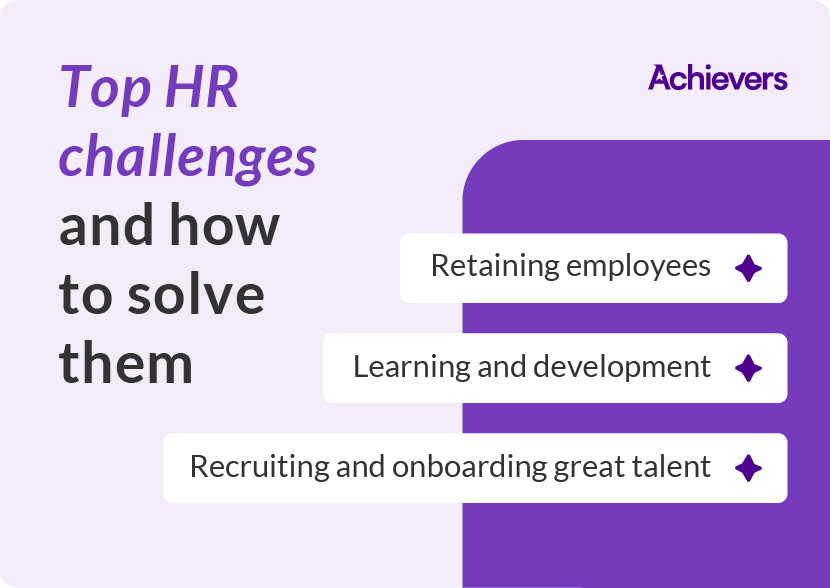Table of contents
As the world advances, the list of HR challenges continues to grow. And changes to the workplace aren’t slowing down, making the job of HR professionals particularly difficult. Overcoming persistent challenges like engaging, recruiting, and retaining employees has become more important than ever.
If you’re looking for help when taking on these tough tasks, you’re in the right place. Let’s dive into the top 20 HR challenges in 2025 and how your organization can take steps to solve them.

The top 20 HR challenges in 2025
1. Employee engagement
Employee engagement indicates how motivated and committed your team members are. Engagement impacts everything from employee retention to your organization’s bottom line. 71% of executives agree that it’s an essential factor in overall organizational success. But chronic disengagement remains an issue at many organizations, especially as they continue to adjust to remote work and the new normal.
Does your organization have the processes needed to drive strong, sustainable employee engagement in place? Engagement is affected by a wide range of factors, including how frequently employees are recognized, whether organizations solicit and act on employee feedback, and to what extent employees are empowered to succeed. You can address these drivers — and many more — in one go with the right employee engagement platform.
2. Supporting leadership
HR departments must ensure that leaders have the knowledge, resources, and constant support they need to excel. Train leaders in how to listen more than they speak, carefully considering and acting on feedback from their direct reports and other employees. HR professionals can educate leadership on how and why to serve as recognition champions as well. When team members see leaders show appreciation frequently, they’re encouraged to follow suit. Finally, HR should help leaders act as coaches rather than micromanaging enforcers, which is one of the best ways to create a culture of positive collaboration.
3. Recruiting and onboarding great talent
Everyone has felt the nervousness and uncertainty that comes with searching for and starting a new job. HR professionals are responsible for turning those feelings into engagement through strong recruiting and onboarding processes.
To ensure your new hires have a great experience with your company from their first contact, develop a winning employer brand those potential employees respect. Build on this by implementing continuous onboarding initiatives like regular check-ins, training refreshers, and mentoring programs. Your company can personalize and improve these initiatives by taking the pulse of team members at every stage of the entire employee life cycle, gathering insights into what employees really want and how their perspectives evolve over time.
4. Retaining employees
Filling empty positions and onboarding brand new team members is important, but HR can’t afford to neglect retaining your organization’s current talent. Strategic Human Resource Management (SHRM) notes that it can cost $30,000 to $45,000 in recruiting and training expenses to replace a manager making $60,000 a year. Low retention rates can also negatively impact your remaining team members in terms of motivation and productivity. Thankfully, there are ways that every company can address and prevent retention issues.
Offer incentives that employees actually value, train managers on how to build trust with their teams, and develop an employee value proposition that team members find hard to resist.
5. Employee health and wellness
HR departments should stay focused on employee wellness, because when team members’ emotional and physical health declines, so does your company’s performance. Unexpected absences cost organizations between approximately $2,600 to $3,600 per year per employee. And employee wellness issues aren’t disappearing anytime soon: 82% of employees were at risk of burnout in 2024, but only half of employers design work with well-being in mind.
Your health and wellness program will be unique to your company, but there are some common actions that are effective across organizations. These include ensuring that team members use available PTO and offering flexible work arrangements that make it easier for them to maintain balance in their lives. Your enterprise should also consider initiatives that increase access to healthy food, provide fun options for exercise, and encourage mindfulness activities.
6. Learning and development
HR professionals need to fully leverage the potential of current team members by fostering a strong company culture focused on learning and growth. If they don’t, they face risks beyond an unprepared, underperforming workforce. In fact, 40% of employees who receive low-quality training choose to leave their job within the first year.
Effective talent development is within the reach of every organization. Some companies can afford to offer tuition reimbursement and cover the costs of attending professional conferences. Even if yours can’t, allocate $100 per year to each employee to spend on online courses to upskill or reskill — or better yet, use modern learning tech to deliver customized training content directly to team members. And any enterprise can further demonstrate its investment in employee growth by establishing clear, achievable career paths for every role.
7. Managing remote teams
When it comes to full-time workers, 12.7% work from home and 28.2% are considered hybrid. Upwork also reports that by 2025, approximately 32.6 million Americans will be working remotely — that’s roughly 22% of the U.S. workforce. But what does this mean for your business? Dispersed teams are here to stay.
Many employees enjoy the perks of this new reality, including flexibility in how, when, and where they work. Your organization has probably realized benefits as well, like reduced overhead and the ability to recruit with fewer restrictions.
Remote work also comes with some potential difficulties HR departments should address. Give remote team members the tools, technology, and training they need to communicate effectively, collaborate easily with other team members, and feel connected to the organization and its culture. Once these basics are taken care of, work to keep remote employees connected and engaged providing them with the same level of recognition and support in-office workers receive.
8. Diversity, equity, and inclusion
Diversity, equity, and inclusion (DEI) are the keys to a healthy organizational culture that attracts the best talent available. That’s why 76% of job seekers and employees say diversity is a key factor when evaluating an organization.
Diversity at work means that your organization has a staff of individuals who bring unique perspectives and backgrounds to your daily projects. Equity involves working to ensure equal opportunities and outcomes for all employees. Finally, inclusion means that team members are valued as unique individuals who feel that they truly belong at your company. HR should keep all three goals front and center while working to establish a true culture of belonging.
9. Building a winning culture
Organizational culture consists of the values, expectations, and practices that guide and inform the team members’ daily actions. A winning culture focuses on positive traits that result in exceptional performance. This requires developing and executing a plan with specific objectives that both HR and all additional team members can work towards and measure.
By prioritizing the five elements of great organizational cultures — recognition, company values, employee voice, belonging, and effective leadership — HR professionals can play a big part in shaping culture for the better. They should also align your employer brand with key aspects of company culture, so it stands out to potential team members from their very first interaction with your company.
10. Employee burnout
More employees are disregarding rest, self-care, and work-life balance to focus on productivity, ambition, and growth. This “hustle culture” mentality has led to an unwanted side effect: employee burnout. Though many employees bring this upon themselves in the hopes of advancing their careers, the reality is this mentality often comes from the top down. To add to this, Mercer’s 2024 Global Talent Trends survey showed that only half of employers prioritize employee well-being, leaving 82% at risk of burnout. That means employers can also be at fault for encouraging or allowing this behavior to occur.
To lower the risk of employee burnout, HR departments and managers might need to make large-scale operational changes like implementing employee well-being programs, reducing employee’s workloads, offering manager training to spot signs of burnout, or revising the company culture or values to place greater emphasis on self-care. However, no change will be effective unless the company culture also changes. This means getting buy-in from all levels of the organization — a task that HR teams are in the perfect position to facilitate.
11. Talent shortages
ManpowerGroup reports that 75% of employers are having trouble filling roles in their organization. Additionally, the U.S. Bureau of Labor Statistics released the results from their Job Opening and Labour Turnover Survey (JOLTS) showing that though there are 8.5 million jobs, there are only 0.8 unemployed people available per job opening. But what does this mean? Essentially fewer employees are leaving their jobs, which is causing a talent shortage for companies in desperate need for new hires.
So how do talent acquisition specialists combat this? They’ll need to get creative. Tackling talent shortages demands a multifaceted approach. By focusing on building an attractive employer brand, diversifying sourcing channels, nurturing talent pipelines, offering competitive compensation and flexible work arrangements, streamlining recruitment processes, embracing technology, prioritizing candidate experience, investing in employee development, and maintaining agility, HR departments can effectively overcome the challenges of today’s competitive job market.
12. Compensation
It’s a conundrum caused by inflation: how do you attract or retain employees with less budget when everyone wants to be paid more? Employees are looking for higher wages and if they can’t get it at their current job, they look elsewhere to find the financial stability they need. But the same companies that lost employees now need to rehire or gap fill, all while meeting the expectations of employees in the same situation as the ones who left. This is the infinity loop HR departments and managers are finding themselves in right now.
So how do you stay competitive in a job market driven by compensation? A good place to start is salary benchmarking. This is the process of reviewing the salaries of open or existing roles against similar companies and industries to ensure you stay competitive. For example, a Harvard Business Review survey found that using a benchmarking tool increases the probability of salary fit for new hires by 22%. It also found that raising existing employees’ salaries by 6% increased overall employee retention by 16% for the next year.
However, benchmarking only gets you so far. The Achievers Workforce Institute (AWI) 2024 Engagement and Retention Report also found that though compensation is the number one reason to job hunt, 72% of employees would choose to stay at a company where they feel supported, cared for and valued over one where they don’t, but get a 30% raise. This shows that emotional salary is just as — if not more — important than pay. And you can improve this by offering a culture that honors and values employees mentally, emotionally and financially.
13. Benefits
Benefits packages play a huge role in employee satisfaction. This is especially true when you consider that one in 10 workers would take a pay cut to get better benefits. But for HR, it hinges on offering enticing benefits to attract and retain top talent and managing costs to safeguard the organization’s financial well-being.
So, what can you do to strike a balance? You can start with a thorough benefits audit to pinpoint areas for improvement. You can also negotiate with providers to score better rates or explore alternative options to save money through customized benefits. A good example of this is health spending accounts (HSAs), which allow employees to pull from a lump sum and put it towards the services they use. Many employees prefer this to being given a blanket amount for certain services they may not even use. Ultimately though, if you want to offer the best benefits package possible, start by listening to your employees and make changes based on their feedback.
14. Change management
Effective change management means communicating openly and transparently, rallying employees around a shared vision, and providing the support and resources they need to thrive in the new landscape. It’s about listening to concerns, addressing resistance, and fostering a culture of adaptability. However, when only 27% of employees feel leadership is trained to lead through change, there’s a lot of room for improvement.
Improving change management in the workplace means creating a clear and compelling vision for the change, soliciting input from employees, and providing transparent communication about the reasons behind the change and its expected outcomes. Offering training and support to help employees develop the necessary skills and navigate the transition is essential, along with addressing any resistance or concerns proactively.
Additionally, leaders must lead by example, demonstrating their commitment to change and cultivating a sense of trust and accountability. Continuously evaluating and adapting the change management strategy based on feedback and lessons learned ensures that the process remains effective and aligned with organizational goals.
15. Conflict resolution
Conflict resolution poses a significant challenge for HR due to its complexity and the potential impact on workplace dynamics. Conflicts can arise from various sources, including disagreements between employees, interpersonal issues, differing work styles, or employee-manager misalignment.
A reported 85% of employees experience some form of conflict at work, showing this is no small problem. Left unaddressed, these conflicts can escalate, leading to increased turnover and decreased morale and productivity. Unresolved conflicts can also create a toxic work environment, which negatively impacts the culture and reputation of the organization.
Improving conflict resolution in the workplace hinges on open communication and transparency. In this, HR takes the lead by facilitating dialogues between conflicting parties, offering a safe space for expression. Through active listening and dialogue, HR professionals can identify conflict root causes, collaborating with employees to find solutions, through mediation or training programs. This is why it’s important to invest in ongoing training for managers, as they play a crucial role in addressing conflicts within their teams. By focusing on communication and emotional intelligence, HR empowers managers to prevent conflicts from escalating and promotes a fair and consistent approach to conflict resolution, ultimately fostering a more harmonious workplace culture.
16. Globalization
Globalization presents numerous challenges for HR professionals as organizations extend their operations across borders. One of the most significant concerns is managing a diverse workforce across different countries and cultures. HR has to handle cultural nuances, legal frameworks, and labor regulations unique to each location while ensuring consistency in policies and practices throughout the organization.
Globalization often involves managing remote teams and collaborating across time zones, which can present communication and coordination challenges. This is so important that 81% of recruiters prioritize cross-cultural communication when hiring globally. Talent acquisition and retention also become more competitive in a global market, requiring HR to develop strategies to attract, develop, and retain top talent from diverse backgrounds.
To tackle globalization challenges, HR professionals need to prioritize cultural awareness and sensitivity through cross-cultural training and resources. Additionally, investing in technology for communication and collaboration across borders is crucial. HR should prioritize diversity and inclusion in talent management strategies, implementing inclusive recruitment processes and supporting career growth for all employees.
17. Performance management
Performance management is a unique challenge for HR. Traditional annual reviews no longer meet the needs of modern workplaces as less than 20% of employees are inspired by reviews. This is leading to disengagement and a lack of alignment between individual and organizational goals, particularly in remote work settings.
To tackle this, HR teams need to shift towards continuous feedback models, emphasizing regular check-ins and real-time coaching between managers and employees. Leveraging technology solutions like performance management software aids in tracking progress and facilitating communication across distributed teams.
It’s also worth considering adopting a holistic approach to performance management, integrating elements such as goal setting, skill development, and career growth opportunities. This multifaceted strategy not only boosts employee engagement and retention but also aligns individual performance with broader business objectives, driving organizational success in today’s dynamic work landscape.
18. Recruitment scams
With the recent rise in remote work opportunities, recruitment scams are unfortunately increasing as well. These scams exploit job seekers by impersonating legitimate employers or recruiters, often leading to financial exploitation and reputational damage for affected organizations. This issue is so pressing that the Federal Trade Commission (FTC) even set up a live dashboard to track reported recruitment scams. And the numbers they report aren’t great; at the time of writing, the total number of reported scams sits at over 176,000, with a total financial loss of over US $645 million since 2019.
To combat this issue, HR professionals need to enhance awareness among both employees and job seekers about the signs of recruitment scams and how to report them. Implementing robust verification processes and screening measures can also help ensure the legitimacy of job postings and recruitment activities, mitigating the risk of scams and protecting both job seekers and the organization’s reputation from harm. For example, many job descriptions will now include a disclaimer stating something like: “all applicants will meet directly (either in person or virtually) with a member of the hiring team before an offer is made.” This is an effort to assure job seekers that they are applying for a legitimate job and can feel safe in applying.
19. Promotions
Here’s a surprising statistic about promotions: a study found that 29% of employees leave their job within a month of being promoted. Why? For some, receiving a new title may boost their confidence, leading them to explore other opportunities where they feel validated. Others might feel dissatisfied with the support, pay raise, or level of recognition they receive after their promotion. Additionally, some employees may feel the promotion came too late, prompting them to seek new challenges elsewhere.
Regardless of the reasons, promotions can be tricky terrain for HR. This is why open communication in the workplace is crucial. Regular feedback and performance evaluations empower employees to develop and grow, increasing their chances for promotion. Providing training opportunities to build necessary skills not only prepares employees for advancement but also fosters a culture of continuous learning.
HR also needs to keep employees informed about promotion opportunities and processes, addressing any concerns along the way. Additionally, HR must stay vigilant to ensure promotions are merit-based and aligned with the organization’s values of fairness and equity. By implementing these strategies, HR can navigate promotions effectively, turning them into opportunities for both individual growth and organizational success.
20. Layoffs
No one likes to think about layoffs, but they’re an unfortunate part of business reality. Not only are layoffs on the rise, but there are certain industries that are much more at risk. Crunchbase reports that there were 93,000 U.S. workers laid off in the tech sector in 2022 and 191,000 in 2023 — a nearly 100% increase year over year.
Though layoffs are sometimes inevitable, HR teams can handle them better by prioritizing open communication and providing support to affected employees while ensuring fairness and adherence to legal requirements. Additionally, they can help prevent layoffs by implementing cost-saving measures, championing talent development initiatives, and creating a culture of transparency and innovation. By taking proactive steps and fostering a supportive workplace environment, HR teams can mitigate the need for layoffs and better navigate workforce challenges.
Overcome your biggest HR challenges
All these HR challenges are surmountable with the help of a solution dedicated to boosting every aspect of the employee experience. The Achievers Employee Experience Platform is a comprehensive ecosystem of tools that help increase engagement, improve culture, and foster a sense of workforce belonging. It includes both Achievers Recognize, a science-driven recognition and reward solution, and Achievers Listen, an engagement tool that captures the employee voice and guides your team from insight to action.
HR challenges FAQ
Key insights
- Employee engagement remains a key driver of organizational success, yet many organizations struggle to maintain it in the face of remote work and changing expectations.
- HR teams must prioritize strategies like continuous learning, personalized onboarding, and robust health and wellness programs to retain top talent and combat burnout.
- Leveraging platforms like Achievers can empower organizations to tackle HR challenges, from improving employee recognition to fostering a culture of inclusion and belonging.



